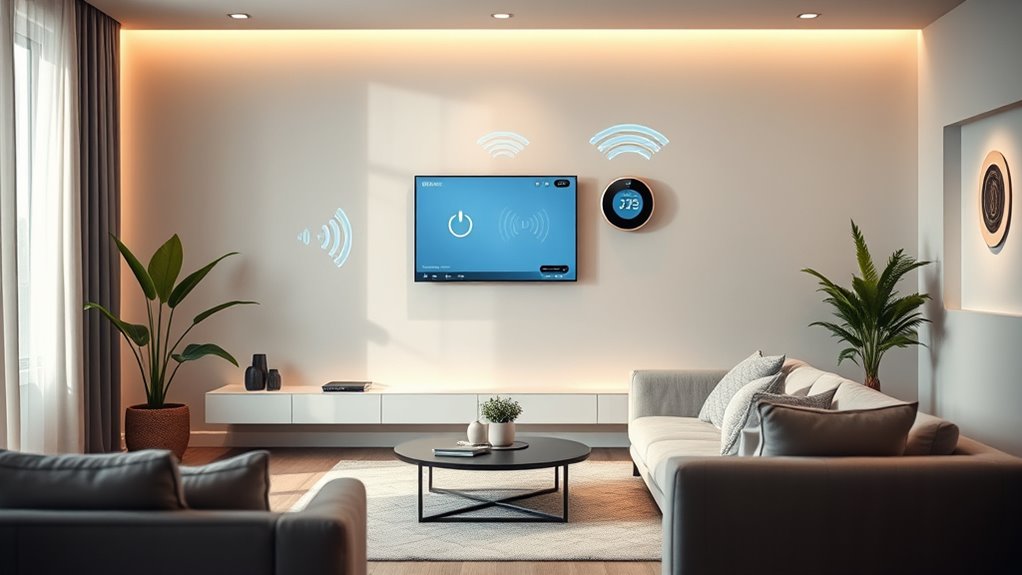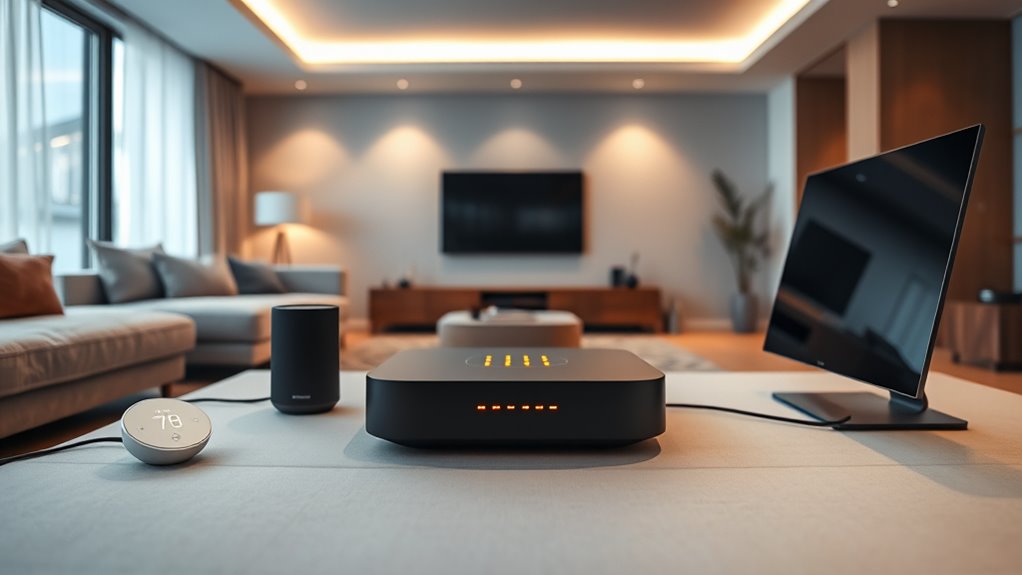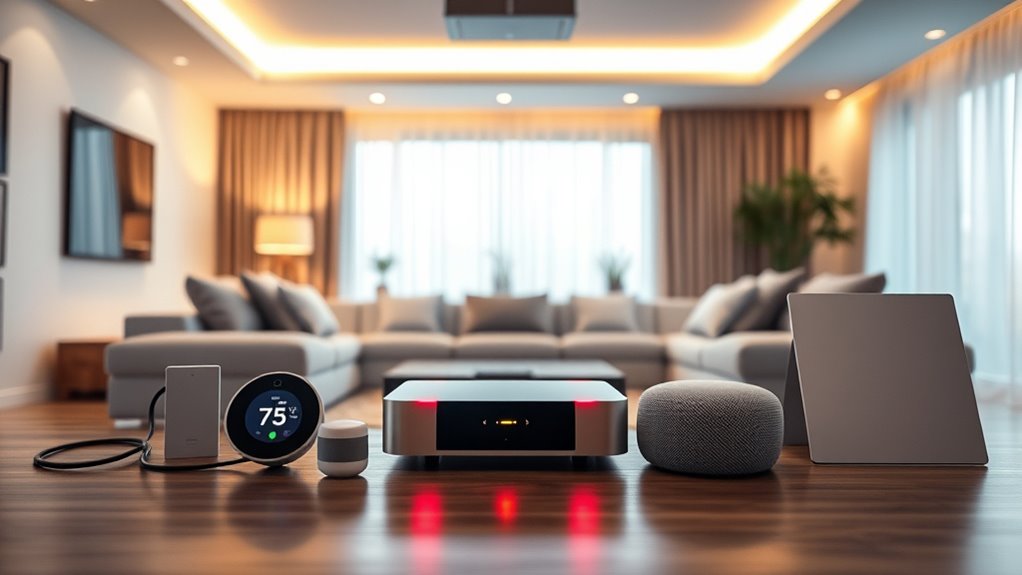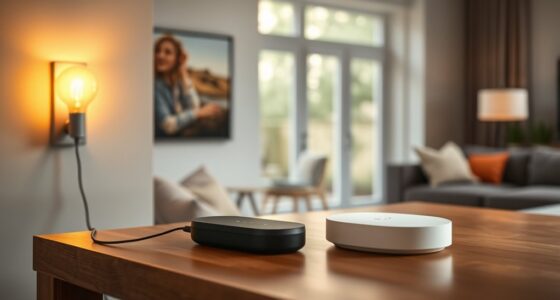To set up your Matter-enabled smart home, start by choosing certified devices that work seamlessly across platforms like Apple, Google, or Amazon. Establish a strong, secure network with good Wi-Fi coverage, segment your smart devices, and use a Matter hub or compatible controllers to manage everything easily. Connect your devices using QR codes or app pairing, and keep firmware updated for security and compatibility. Continuing will reveal how to optimize performance and guarantee your smart home stays future-proof.
Key Takeaways
- Choose Matter-certified devices compatible with your smart home platform for seamless interoperability and reliable performance.
- Use QR codes or ecosystem apps to securely pair and add Matter devices to your network.
- Set up a robust, secure network with strong passwords, network segmentation, and mesh Wi-Fi or Thread for optimal connectivity.
- Ensure firmware updates and device certification to maintain security, compatibility, and future-proof your smart home.
- Organize devices into zones or rooms, create automations, and leverage integrated hubs for centralized control and enhanced user experience.
Understanding the Core Principles of Matter Protocol

Understanding the core principles of the Matter protocol is essential because it forms the foundation for seamless smart home device communication. Matter is an open-source, IP-based standard that unifies various brands and device types, making setup and control straightforward. Developed by the Connectivity Standards Alliance, it aims to eliminate fragmentation in smart homes by supporting multiple underlying technologies like Wi-Fi, Ethernet, Bluetooth LE, and Thread mesh networking. The protocol ensures secure, reliable connections, protecting your data through authentication and encryption. Operating over IP networks, Matter enables devices such as lights, sensors, locks, and thermostats to communicate effortlessly. Its primary goal is to create a unified ecosystem where devices from different manufacturers work together smoothly, enhancing your overall smart home experience. Additionally, high refresh rates in compatible devices ensure smooth operation and real-time responsiveness within the ecosystem.
Selecting Compatible Matter Devices for Your Smart Home

Choosing the right Matter-compatible devices depends on your existing smart home setup and the platform you prefer. Your choice should align with the ecosystem you’ve already invested in, such as Apple HomeKit, Google Home, or Amazon Alexa, since each has different device support and hardware requirements. Some platforms need specific hubs or control centers, like Apple TV 4K or SmartThings hubs, to manage your devices effectively. Consider the types of devices you want—smart thermostats, locks, lights, or speakers—and check their compatibility with your chosen platform. Look for Matter-certified devices, as they ensure seamless interoperability across ecosystems. Additionally, verifying the Indoor air quality capabilities of devices can enhance your smart home’s overall environment. Incorporating AI-driven insights can help optimize device performance and energy efficiency over time. Also, understanding the Vetted – Doomsday Robots can help you select more reliable and secure devices for long-term use. To ensure your setup remains resilient, choosing brands that prioritize software updates and security patches is essential for long-term compatibility and protection. Furthermore, considering the energy management features of devices can contribute to more sustainable and cost-effective operation. Finally, selecting reputable brands that support future updates will help your smart home stay compatible and functional long-term.
Establishing a Robust Network Infrastructure for Seamless Connectivity

To guarantee your Matter‑enabled smart home runs smoothly, you need to optimize Wi-Fi coverage and integrate Thread networks for reliable connectivity. Securing your network with strong passwords and updated firmware is essential to protect your devices. By focusing on these key points, you create a robust infrastructure that supports seamless device communication and security. Additionally, understanding Relationships – Personality Test can help in designing user-friendly interfaces that foster better interaction within the smart home environment. Incorporating reputable Juice Brands known for quality and reliability can also enhance your home automation experience by ensuring compatible and trustworthy devices. Recognizing the 16PF traits that influence user preferences can further tailor your system to meet individual needs effectively, especially by considering network security best practices to defend against potential cyber threats. Implementing sound design principles in user notifications and alerts can improve clarity and response times within your smart ecosystem.
Optimize Wi-Fi Coverage
Establishing a strong Wi-Fi coverage foundation is essential for a seamless smart home experience. To do this, assess your device bandwidth needs—low, moderate, or high—and choose a router that can handle multiple connections without slowing down. Modern Wi-Fi 6E or tri-band routers improve performance by managing devices across different bands. Glycolic acid, known for its exfoliating properties, can be incorporated into skincare routines to enhance skin texture and clarity, emphasizing the importance of a comprehensive approach to home wellness. For large or multi-story homes, mesh Wi-Fi systems ensure coverage in every corner, reducing dead zones. Place extenders or mesh satellites strategically—about halfway between the router and weak spots—to maintain signal strength. Use a single SSID across bands for easy device roaming, and consider wired solutions like Ethernet-over-Coax for hard-to-wire areas. Proper coverage minimizes dead zones, dropped connections, and latency, keeping all your Matter-enabled devices connected reliably. Additionally, selecting a router capable of handling multiple connections can further optimize network performance and ensure smooth operation for all connected devices. Ensuring your network infrastructure is designed with the layout of your home in mind can help prevent coverage gaps and optimize overall performance. Incorporating a robust network infrastructure tailored to your home’s architecture enhances the stability and reach of your smart home system.
Integrate Thread Networks
Integrating Thread networks into your smart home infrastructure creates a reliable, low-power mesh that enhances device communication and coverage. Each device acts as a router, relaying messages and expanding the network’s reach, even in hard-to-reach areas. A Thread border router bridges the mesh to your Wi-Fi or Ethernet, enabling seamless connectivity. Proper setup involves selecting Matter-compatible devices supporting Thread, configuring the border router, and setting network parameters like name and channel. Regular firmware updates ensure stability and compatibility. To visualize, consider this table:
| Device Type | Function | Coverage Area |
|---|---|---|
| Thread Device | Relays messages, extends mesh | Whole home |
| Border Router | Connects Thread to other networks | Central hub |
| End Device | Controls specific smart devices | Local zones |
This setup guarantees a resilient, efficient smart home network.
Prioritize Network Security
Securing your smart home network is essential for reliable device performance and protecting your privacy. Start by changing your router’s default login credentials to strong, unique ones, and regularly update its firmware to patch vulnerabilities. Disable remote management and turn off WPS to prevent exploitation. After setup, disable UPnP to reduce malware risks. Segment your network by creating separate VLANs or SSIDs for smart devices and critical systems, and implement firewall rules to control traffic between them. Use a dedicated guest network with a strong password for visitors, keeping IoT devices isolated from your main network. Connect Matter devices to the primary network with robust security settings. Additionally, prioritize network segmentation to enhance security and control access within your smart home. Finally, store your networking equipment securely, monitor traffic routinely, and educate household members on best practices to maintain a resilient, secure setup.
Setting Up Your Matter Hub or Controller

Setting up your Matter hub or controller starts with choosing a compatible device that fits your ecosystem, such as an Apple TV, Amazon Echo, or a smart home hub like Samsung SmartThings. Make certain the device supports the latest Matter updates and the protocols you plan to use, like WiFi, Ethernet, or Thread. Once selected, connect it to your home network via WiFi or Ethernet, and update the firmware to the latest version. Use the corresponding app—like Apple Home or Google Home—to initiate pairing and set it as your primary controller. From there, you can discover and manage your Matter devices easily. Additionally, selecting a device with compatibility for multiple protocols ensures seamless integration across your smart home ecosystem. Being aware of potential family photoshoot fails can help you troubleshoot unexpected issues during device setup, such as miscommunications or unplanned glitches, making the process smoother. Ensuring your devices are up-to-date with firmware can prevent compatibility issues and enhance overall stability during setup, especially when utilizing Vetted – AP Tuning techniques to optimize network performance. Incorporating interoperability standards can further improve device communication and reliability within your smart home network.
Adding and Managing Matter-Enabled Devices

Once you’ve set up your Matter hub or controller, the next step is adding and managing your Matter-enabled devices. To do this, put each device in pairing mode—usually by pressing a button or following specific instructions—and scan its QR code or manually input pairing info in your controller app. Devices communicate via Wi-Fi or Thread, creating reliable mesh networks that improve connectivity. Many smart devices like bulbs, locks, and thermostats from brands such as Aeotec and Leviton are compatible. Firmware updates can make some existing Wi-Fi devices Matter-ready, while Zigbee devices typically connect through bridging hubs. You can organize devices by rooms or zones, control them locally or through multiple apps, and create automations or routines that coordinate actions across brands—all with secure, encrypted connections. Incorporating mesh networking enhances device management and user experience. To maximize the benefits of wireless protocols, ensure your network is robust and optimized for smart home devices. Additionally, understanding smart home standards can help you make more informed choices about device compatibility and future-proofing your setup.
Integrating Matter Devices With Major Smart Home Ecosystems

To successfully integrate Matter devices with major smart home ecosystems, you need to understand compatibility tips and pairing strategies. Ensuring your devices and controllers support the right protocols and meet hardware requirements will streamline setup and improve reliability. Additionally, selecting vetted products can help you avoid compatibility issues and ensure long-term performance. Being aware of regional resources and local support options can also facilitate troubleshooting and updates. For example, understanding the divorce process in various states can help you navigate legal procedures more effectively, which is analogous to understanding technical procedures in smart home integration. By following these guidelines, you can create a seamless, cross-platform smart home experience.
Ecosystem Compatibility Tips
Integrating Matter devices with major smart home ecosystems is straightforward, thanks to the standard’s focus on interoperability. To guarantee seamless compatibility, start by checking if your devices display the Matter certification logo, which guarantees they meet security and functionality standards. Keep your ecosystem platforms updated, as providers continuously add support for new Matter device types, expanding your options. Use ecosystem-specific apps like Google Home, Apple Home, or Alexa to confirm device compatibility and manage settings easily. Also, consider the network protocols—Wi-Fi and Thread are common, so ensure your devices and hubs support these for excellent performance. Finally, look for devices labeled “Works with [Ecosystem],” which indicates smooth integration and reliable operation across platforms.
Device Pairing Strategies
Connecting Matter devices to your smart home ecosystems relies heavily on effective pairing strategies. The primary method is QR code scanning, often through the Google Home app or ecosystem-specific apps. The Google Home app’s intuitive interface guides you through device discovery, home selection, and QR code scanning. For advanced users or third-party integrations, Android SDKs and developer tools provide alternative pairing routes. These protocols prioritize local network communication via Thread or Wi-Fi, eliminating reliance on cloud servers for faster, more secure setup. If initial pairing fails, activating developer options or generating bug reports can help troubleshoot. Each major ecosystem—Google, Apple, and Amazon—uses its own hub or controller hardware to manage Matter devices locally, ensuring reliable, secure, and seamless integration across platforms.
Optimizing Device Performance and Reliability

Optimizing device performance and reliability in a Matter-enabled smart home involves several key strategies. First, ensure your network is robust by setting up a stable Wi-Fi or Thread mesh network. This minimizes latency, prevents command delays, and maintains consistent connections. Second, regularly update firmware and software on all devices to enhance compatibility, fix bugs, and improve performance. These updates also strengthen security and interoperability. Lastly, monitor power consumption for battery-operated devices like sensors and locks. Using smart sleep modes, proper placement, and timely battery replacements help conserve energy and prevent downtime.
Boost smart home reliability with a stable network, timely updates, and efficient power management.
- Set up a reliable mesh network to enhance communication.
- Keep firmware and software up to date automatically.
- Manage power efficiently to extend device longevity.
Maintaining Security and Privacy in a Matter-Enabled Environment

Ensuring your smart home remains secure and private is just as important as maintaining device performance. Matter’s built-in security features, like encryption and authentication, protect all communications by default. Devices undergo formal certification to confirm compliance, and secure onboarding methods—such as encrypted QR codes or Bluetooth—prevent unauthorized access during setup. Secure commissioning verifies device authenticity before connection, while end-to-end encryption safeguards data in transit. Device authenticity is checked before network access, reducing risks from rogue devices. Matter uses randomized, encrypted node IDs to minimize tracking and spoofing. It supports local communication and limits device capabilities, reducing attack surfaces. Regular firmware updates, strong passwords, and network segmentation further enhance security, helping you maintain a private, resilient smart home environment. Assessing insurer’s financial stability and incorporating security measures can further protect your investment and privacy in your smart home ecosystem.
Expanding and Improving Your Smart Home With Future-Proof Technologies

To future-proof your smart home, embracing integrated control hubs and cross-brand compatibility is essential. These hubs, like Amazon Echo or Google Nest, let you manage lighting, security, and climate from one platform, saving you from juggling multiple apps. They also feature intuitive voice control and sleek panels for hands-on use. Cross-device integration is improving, so different brands work smoothly together, reducing frustration. You can control indoor and outdoor systems effortlessly via unified apps or voice commands. Staying aware of store hours can also help you plan the best times to purchase new smart home devices or schedule installations. Additionally, understanding interoperability standards can ensure your devices will work seamlessly as your system expands, especially as more hydrogen fuel cell technologies become integrated into sustainable home energy solutions. Exploring attention-focused practices can also enhance your ability to troubleshoot and optimize your smart home setup effectively.
Frequently Asked Questions
How Does Matter Impact Existing Smart Home Device Compatibility?
Matter enhances your smart home configuration by making devices from various brands cooperate seamlessly. If your existing devices use Wi-Fi, Thread, or Ethernet, they can often receive firmware updates to become Matter-compatible, extending their lifespan. This means you won’t need to replace devices and can enjoy easier control and integration. Just verify your devices are certified and connected to your primary network for the best performance.
Can I Upgrade My Current Devices to Support Matter?
You can upgrade some of your current devices to support Matter, but it depends on their hardware and manufacturer support. Many Wi-Fi devices may get firmware updates, while devices without the necessary hardware can’t be upgraded. Check with your device makers or manuals to see if firmware updates are available. For devices lacking upgrades, using hubs or bridges can help integrate them into a Matter network, ensuring compatibility and seamless operation.
What Troubleshooting Steps Are Recommended for Connectivity Issues?
Think of your smart home as a delicate dance, where every step counts. When connectivity falters, you’re missing a beat. To troubleshoot, restart your router, hub, and devices to reset the rhythm. Confirm your Wi-Fi is strong and stable, with no obstacles blocking the signal. Keep firmware updated, and avoid setting up multiple devices at once. Regular checks and patience will help your smart home stay in perfect harmony.
How Do Firmware Updates Affect Matter Device Functionality?
Firmware updates directly impact your Matter devices by adding new features, fixing bugs, and enhancing security. They guarantee your devices stay compatible with evolving protocols and maintain smooth operation within your smart home ecosystem. When you update firmware, your devices can support new device types, improve performance, and stay interoperable across platforms like Alexa or Apple HomeKit. Regular updates keep everything running reliably and securely, protecting your smart home from vulnerabilities.
Are There Specific Security Features Unique to Matter-Enabled Devices?
Did you know that 85% of smart home security breaches involve device vulnerabilities? You’ll find Matter-enabled devices have unique security features like cryptographic certificates verifying device authenticity, end-to-end encryption, and automatic mutual authentication. These measures guarantee your devices communicate securely, preventing unauthorized access. Plus, local network communication limits exposure to cloud attacks, and multi-admin controls safeguard device interoperability across platforms, making your smart home safer and more reliable.
Conclusion
Getting your smart home Matter-enabled is easier than you think. Some worry about compatibility or security, but with proper setup and choosing the right devices, you’ll enjoy a seamless, reliable experience. Remember, investing a little time now guarantees your smart home stays future-proof, secure,, and effortlessly connected. Don’t let tech concerns hold you back—embrace Matter and transform your living space into a truly intelligent home you’ll love.







